

Chronic conditions present a strong economic incentive for action. During the past century, a major shift occurred in the leading causes of death for all age groups, including older adults, from infectious diseases and acute illnesses to chronic diseases and degenerative illnesses. More than a quarter of all Americans, and two of every three older Americans, have multiple chronic conditions. Treatment for this chronic-conditions population accounts for 66% of the country’s healthcare budget.1
Mobility is fundamental to everyday life and central to an understanding of health and well-being among older populations. Impaired mobility is associated with a variety of adverse health outcomes. As the age of the US population continues to increase, aging and public health professionals have a growing role to play in improving mobility for older adults. There are critical gaps in the assessment and measurement of mobility among older adults who live in the community, particularly those who have physical disabilities or cognitive impairments. By changing the physical environment in which older people live and creating unique integrated interventions across various disciplines, we can improve mobility for older adults.
As expected, the aging population is prone to higher rates of nearly all musculoskeletal conditions than those found in younger people. In large part, these conditions can be attributed to wear and tear on bones and joints over a lifetime. However, some musculoskeletal conditions such as back pain are equally prominent in younger age populations, particularly those in their middle ages.
Arthritis is self-reported in 2012 at the highest among persons aged 75 years and older (49%), but by nearly as many in the 65- to 74-year age range (47%). Only 30% of ages 45 to 64 years self-report they have a form of arthritis. Chronic joint pain, however, is reported at the highest rate by the 65- to 74-year age group, with both those aged 75 years and older and 45 to 64 years reporting rates of chronic joint pain at close to this rate. Low back pain, on the other hand, was self-reported at the highest rate by persons aged 45 to 64 years, closely followed by all persons age 65 years and older. Overall, 126.6 million people age 18 years and older self-reported one or more types of musculoskeletal conditions in 2012. (Reference Table 9B.1 PDF [2] CSV [3])
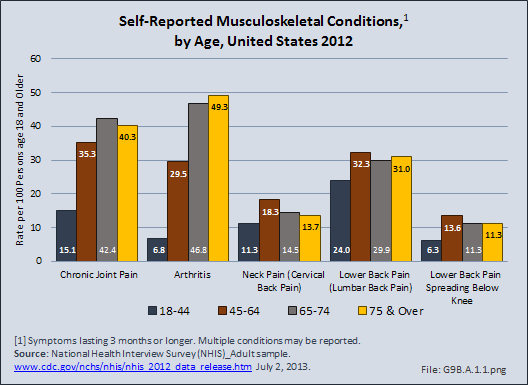
The most common chronic joint pain reported by the 63.1 million people of all ages is knee pain, followed by shoulder pain. However, the rate per 100 people reporting chronic pain in specific joints varies by age. Knee pain is reported by 22% to 26% of people age 45 years and older, with these age groups reporting shoulder pain at rates of 11% to 13.5%. Hip and finger joint pain are both reported at higher rates by people age 65 years and older, while ankle pain has the highest rate among people aged 45 to 64 years. Joint pain in the ankle, wrist, elbow, and toes is lower among those in the oldest age group, compared to those 45 to 74 years of age, possibly due to being less active and placing lower stress on these joints. (Reference Table 9B.1 PDF [2] CSV [3])
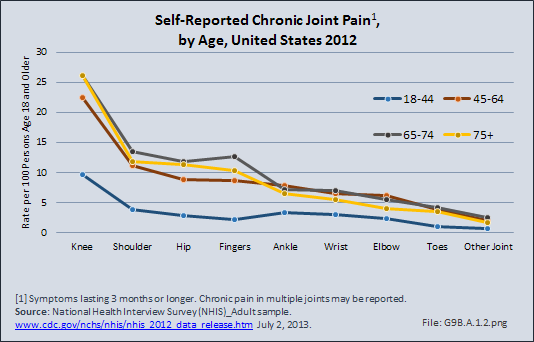
An estimated 6 in 100 persons report they have limitations performing activities of daily living such as dressing, bathing and walking due to musculoskeletal conditions. However, the rate with limitations rises steadily as the population ages, from just over 2 in 100 for those age 18 to 44 years, to 23 in 100 for people who have reached the age of 75 years. The highest rate of limitation is due to arthritis in the oldest group, but due to back or neck problems in the younger ages. (Reference Table 9B.1 PDF [2] CSV [3])
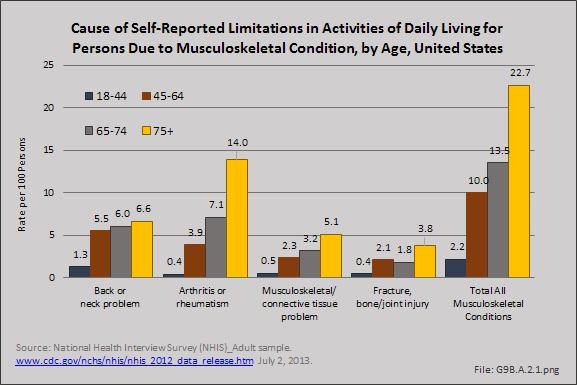
People age 45 to 64 years accounted for one-half (49%) of the 528.3 million bed days from a musculoskeletal condition that were reported in 2012 by people age 18 years and older. A bed day is defined as one-half or more days in bed due to injury or illness, excluding hospitalization. The greater number of total bed days reported by this age group is due to a high mean of 10.4 days combined with close to half the population reporting bed days because of a musculoskeletal condition. (Reference Table 9B.1 PDF [2] CSV [3])
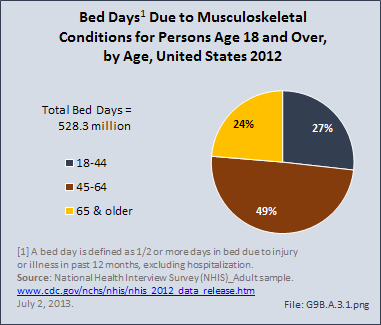
This same age group also accounted for slightly more than half (56%) of the 216.5 million lost work days due to musculoskeletal conditions reported by people age 18 years and older and in the workforce. People aged 65 years and older reported only 5% of total lost work days because of the low number that are still in the workforce. (Reference Table 9B.1 PDF [2] CSV [3])
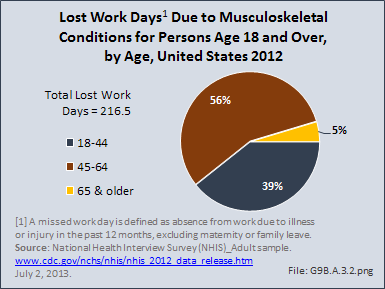
Links:
[1] http://www.nia.nih.gov/newsroom/features/nih-seeking-strategies-multiple-chronic-conditions-older-people
[2] https://bmus.latticegroup.com/docs/T9B.1.pdf
[3] https://bmus.latticegroup.com/docs/T9B.1.csv